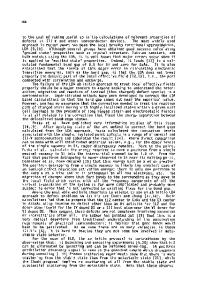Pressure and Strain Effects on Diffusion
- PDF / 484,204 Bytes
- 6 Pages / 420.48 x 639 pts Page_size
- 80 Downloads / 313 Views
PRESSURE AND STRAIN EFFECTS ON DIFFUSION A. Antonelli and J. Bernholc Department of Physics, North Carolina State University, Raleigh, NC 27695 ABSTRACT We have investigated, via parameter-free calculations, the effects of hydrostatic and nonhydrostatic strains on the energetics of defect formation and self-diffusion in silicon. The three microscopic mechanisms, vacancy, interstitial, and concerted exchange, have very similar activation enthalpies at zero pressure but exhibit different behavior with hydrostatic pressure. Our results suggest that experiments performed at different pressures can determine the relative contributions of each of these mechanisms. The calculations also show that the neutral Si vacancy has a negative relaxation volume, with the nearest neighbors of the vacancy relaxing inwards, in contrast to the Si (111) surface. Large nonhydrostatic strains, which are present in e.g. Si/GexSil-x pseudomorphic heterostructures, substantially reduce the formation energy of the tetrahedral interstitial, but do not affect the formation energy of the vacancy. These findings suggest that, aside from being another useful tool for the investigation of self-diffusion in Si, nonhydrostatic strain may significantly affect annealing and impurity diffusion in strained heterostructures. In particular, the interstitial-assisted impurity diffusion may proceed more rapidly in Si lattice-matched to GexSil-x, but be slowed down in GexSil-x lattice-matched to Si. The compressed GexSil-x layers may thus act as diffusion barriers for impurities diffusing with help of native interstitials, such as B or P. INTRODUCTION The microscopic understanding of self-diffusion in silicon remains a controversial issue, despite extensive experimental and theoretical efforts. Various microscopic mechanisms have been proposed, but their relative importance has not yet been determined. Experimental measurements using different techniques have shown that the self-diffusion activation energy varies from 4.1 to 5.1 eV in the temperature range of 1100 to 1500 K [1]. Native defects are the natural candidates to mediate self-diffusion. Since it is known experimentally that the concentration of complex defects in Si is negligible [2] only simple defects need to be considered. Theoretical studies [3,4] have shown that the vacancy and interstitial mechanisms have very similar activation energies, both within the experimentally measured range. More recently, Pandey [5] proposed the concerted exchange mechanism, which has an activation energy similar to the ones of the defect mechanisms. Until now, however, both theoretical approximations and experimental uncertainties have precluded the determination of the relative contributions of each of these mechanisms to the self-diffusion process. Hydrostatic pressure has long been used to investigate diffusive processes in metals and ionic compounds. Several experimental results can be found in the literature from over twenty years ago [6]. Due to experimental difficulties, however, the first studies of pressur
Data Loading...









